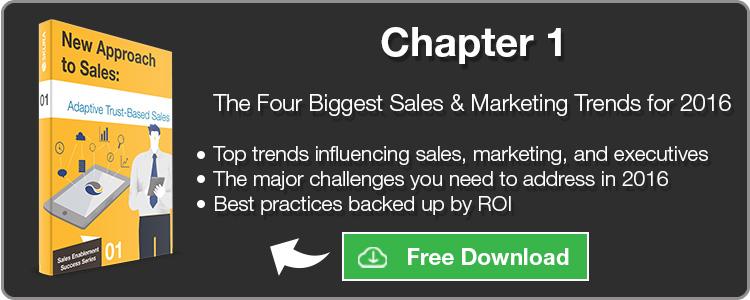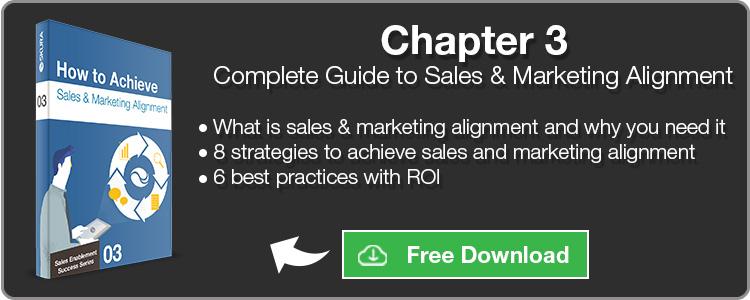We’ve been talking a lot about the sales stack and how it forms a holistic engagement solution for your client-facing business units (sales, marketing, service, etc.) but we can sometimes get caught up in the terminology and forget that just because it’s called a “sales” tool, it doesn’t mean sales-only tool.
The sales process simply facilitates a buyer decision journey, of which marketing is a part. Today we expand on sales enablement technology to help marketing teams understand how and why ‘sales’ enablement is just as important for marketing.
If you’re completely new to sales enablement software, I suggest starting with our 2016 simplified definition of sales enablement.
Sales Enablement for Marketing
Why not just use Marketing Automation?
Though adoption will vary between industry and firm size, marketing automation is a popular and effective program for a digital sales process, and is crucial for an effective digital content marketing approach.

(Image Source: MEG.com, 2014)
Marketing teams are the primary producers of content for sales reps,
Content marketing, made easy with marketing automation, is now a dominant form of marketing with anywhere from 86% to 96% of B2B marketers indicating adoption in a 2015 Content Marketing Institute Benchmarks, Budgets, and Trends report.
Not including staff, the average marketing budget spent on digital content now rests at 28% (Source: Content Marketing Institute, 2014), and as much as 84% of digital content is created by the marketing team.
Unfortunately, that content tends to miss the mark on usefulness for sales,
75% of sales reps report that they ‘occasionally’ or ‘never’ get what they need from the marketing team, and 78% of sales leaders have reported that their sales teams are creating their own sales presentation materials.
Specifically, they feel:
- It’s too generic (67%)
- Not relevant enough to the buyer (40%)
- Prefer to create their own (36%)
- Content is out of date (20%)
(Source: Firebrick Consulting, 2012)
Or worse, the content never ends up making it to the sales team at all,
Only 9% of businesses reported using a dedicated content management system to disseminate content to the field, meanwhile the most popular formats don’t make content more accessible, and in fact put up road blocks.
Here’s a breakdown of popular digital content management strategies:
- 22% - A cloud storage system (Dropbox, Box, Google Drive, etc.)
- 22% - Email attachments
- 18% - CRM or Sales Force Automation
- 17% - An Intranet
- 9% - Personal hard drive
When you’re juggling old email attachments it’s easy to see why one in five sales reps prefer to make their own content, or feel the current library is out of date.
The icing on the cake - many marketers aren’t sure what they should be making anyway,
Though most use marketing automation for their digital content, 17% stated they had no content effectiveness measurements, and 48% felt they only made basic use of their content effectiveness measurements (Source: DemandMetric, 2014).
Moreover, as few as 12% of sales teams are regularly included in the creation of customer facing material.
[RELATED CONTENT] Sound bad? Content issues only represent one of four major challenges brands must address in 2016. Download our FREE eBook on the changing state of sales for more.
How does Sales Enablement Enable Marketing?
Sales enablement software serves these crucial functions for marketing,
1) It Creates Sales and Marketing Alignment
Your sales and marketing teams probably operate in silos, sending content and leads back and forth behind a curtain of obscurity and blaming the other for their problems. Sales and marketing alignment is achieved by lifting that curtain and pushing sales level insight to the marketing team.
Why? Right now few sales teams are included by marketing in digital content creation, even though sales will be using this content and are aware of what they need.
It can be tough to just ask your teams to sit down and collaborate, but you can push back the data for shared insights.
Now I know what you’re asking:
“My marketing automation system gives me plenty of data, what difference does sales enablement offer?”
Fair question, for this you need to recognize scopes.
- Marketing – creates inbound content > brings in leads > sends those leads to sales when ready.
- All interactions are tracked in marketing automation.
- Marketers optimize their content for lead generation.
- Sales – receives marketing content & leads > shares content & develops relationships > closes the sale.
- No insight from the content. No insight from the lead.
- Marketers use anecdotal evidence from sellers, or none at all.
Marketers have no idea how effective content is for closing, nor do they know the quality of leads being generated. They become highly tuned engines for lead generation, but not closing.
Here’s what it looks like with sales enablement:

And here’s what it delivers:
|
Believe Content is Effective For: |
With Sales Consumption Insight |
No Sales Consumption Insight |
|
Lead Generation |
78% |
49% |
|
Closing |
54% |
21% |
[RELATED CONTENT] Interested in learning more about sales and marketing alignment? CLICK HERE for a free copy of our guide to creating sales and marketing alignment.
2) It Supports Distribution
90% of sellers navigate inappropriate means of digital content management, where sales enablement offers a content management solution that enables contextually relevant impulse accessible content consumption.
We explained the concept of ‘perfect content management’ in a previous article. It should also be noted that sales enablement occupies the #4 spot in the top 5 essential components of any sales stack for this exact reason.
3) It Enables the use of an Integrated Marketing Communications Strategy that Includes Sales
With marketers creating a majority of digital content, few analyzing any data, and many sellers opting to create their own out of frustration, the current format of communications are neither integrated nor coordinated. If anything, current practices deteriorate any chance of integrated marketing communications (IMC).
In a later post I’ll dig deeper into how sales enablement software specifically creates IMC with sales reps. Subscribe to our mailing list for an instant notification upon release. A link will be posted here as well.
It can be frustrating to be a marketer these days. Painstakingly creating digital content, struggling to coordinate the communications of a global sales force, and starving for target market awareness. GSK marketers using SKURA say their content is implemented “absolutely perfectly in local markets”, Request a demo and let us show you how SKURA can work for you.













